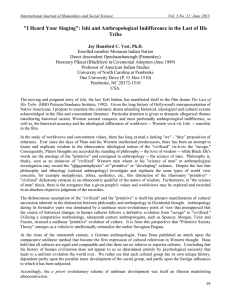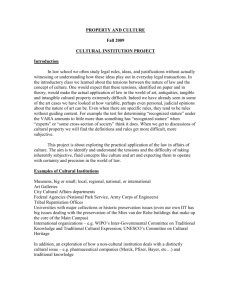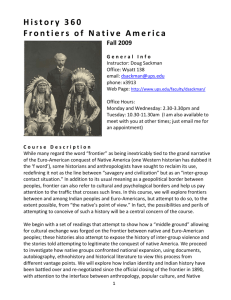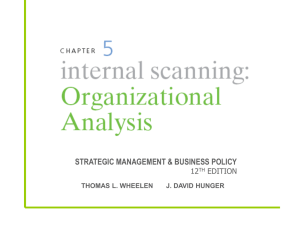Framing Ishi`s legacy is a complex task
advertisement
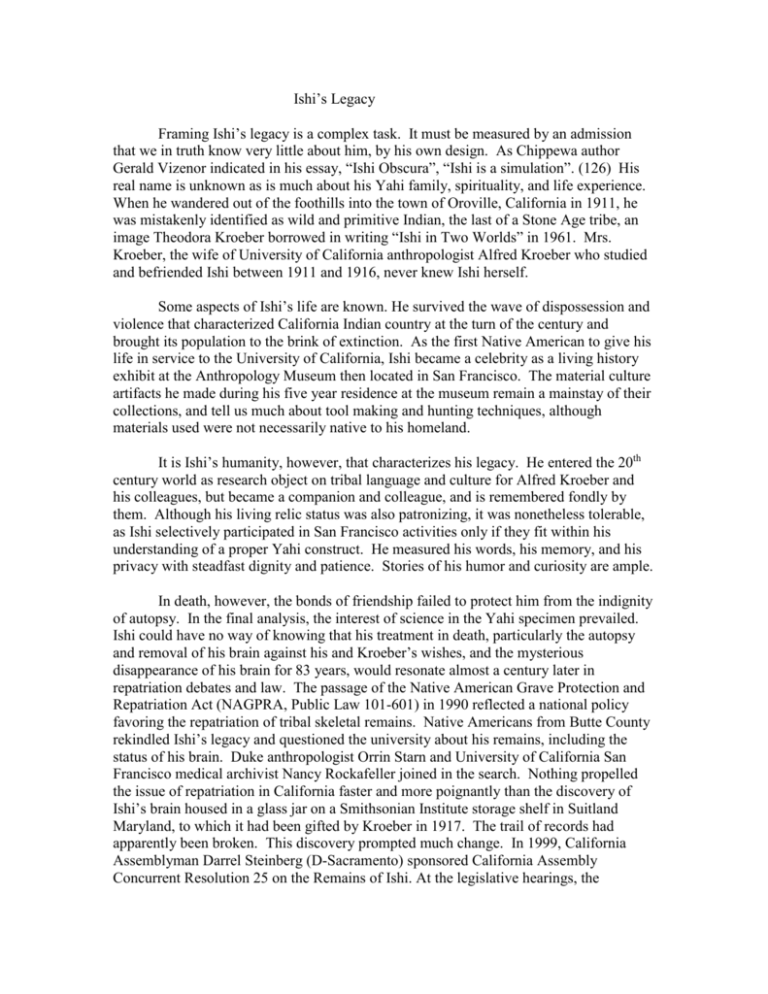
Ishi’s Legacy Framing Ishi’s legacy is a complex task. It must be measured by an admission that we in truth know very little about him, by his own design. As Chippewa author Gerald Vizenor indicated in his essay, “Ishi Obscura”, “Ishi is a simulation”. (126) His real name is unknown as is much about his Yahi family, spirituality, and life experience. When he wandered out of the foothills into the town of Oroville, California in 1911, he was mistakenly identified as wild and primitive Indian, the last of a Stone Age tribe, an image Theodora Kroeber borrowed in writing “Ishi in Two Worlds” in 1961. Mrs. Kroeber, the wife of University of California anthropologist Alfred Kroeber who studied and befriended Ishi between 1911 and 1916, never knew Ishi herself. Some aspects of Ishi’s life are known. He survived the wave of dispossession and violence that characterized California Indian country at the turn of the century and brought its population to the brink of extinction. As the first Native American to give his life in service to the University of California, Ishi became a celebrity as a living history exhibit at the Anthropology Museum then located in San Francisco. The material culture artifacts he made during his five year residence at the museum remain a mainstay of their collections, and tell us much about tool making and hunting techniques, although materials used were not necessarily native to his homeland. It is Ishi’s humanity, however, that characterizes his legacy. He entered the 20th century world as research object on tribal language and culture for Alfred Kroeber and his colleagues, but became a companion and colleague, and is remembered fondly by them. Although his living relic status was also patronizing, it was nonetheless tolerable, as Ishi selectively participated in San Francisco activities only if they fit within his understanding of a proper Yahi construct. He measured his words, his memory, and his privacy with steadfast dignity and patience. Stories of his humor and curiosity are ample. In death, however, the bonds of friendship failed to protect him from the indignity of autopsy. In the final analysis, the interest of science in the Yahi specimen prevailed. Ishi could have no way of knowing that his treatment in death, particularly the autopsy and removal of his brain against his and Kroeber’s wishes, and the mysterious disappearance of his brain for 83 years, would resonate almost a century later in repatriation debates and law. The passage of the Native American Grave Protection and Repatriation Act (NAGPRA, Public Law 101-601) in 1990 reflected a national policy favoring the repatriation of tribal skeletal remains. Native Americans from Butte County rekindled Ishi’s legacy and questioned the university about his remains, including the status of his brain. Duke anthropologist Orrin Starn and University of California San Francisco medical archivist Nancy Rockafeller joined in the search. Nothing propelled the issue of repatriation in California faster and more poignantly than the discovery of Ishi’s brain housed in a glass jar on a Smithsonian Institute storage shelf in Suitland Maryland, to which it had been gifted by Kroeber in 1917. The trail of records had apparently been broken. This discovery prompted much change. In 1999, California Assemblyman Darrel Steinberg (D-Sacramento) sponsored California Assembly Concurrent Resolution 25 on the Remains of Ishi. At the legislative hearings, the University Anthropology Department offered a public apology for its role in Ishi’s “final tragedy” and indicated a desire for renewed cooperation with the California Indian community. Members of the Pit River and Redding Rancheria tribal communities testified about shared remembrances and affiliations with Ishi’s Yahi community, triggering a determination for repatriation of his brain to them under NAGPRA. In August, 2000, Ishi’s brain was reunited with his cremated remains and buried privately in an undisclosed location in the shadow of Mt. Lassen. Ishi’s real legacy, ultimately, can best be remembered as that of a human being whose selective disclosure of knowledge and experience constituted active resistance; a man who was intellectually curious and generous of spirit in reciprocal relationships. He was an imaginative survivor of one of the most lethal chapters in American history, but never a victim. Instead, with only a 600-word vocabulary, Ishi cemented his place in history and memory. In addition to the Ishi collection at the Hearst Museum, a shared exhibit is currently on display at the California Indian Museum in Santa Rosa. Thanks to the generous leadership and curatorial talents at the Hearst, Ishi’s objects in this place further its mission to honor California Indians and educate the public from a native perspective. Efforts by Gerald Vizenor resulted in an interior courtyard of Dwinelle Hall being renamed after Ishi on the Berkeley campus. And finally, recent scholarly contributions like Ishi in Three Centuries (edited by Kroeber’s sons Karl and Clifton, an essay from which this piece is drawn) position Ishi’s humanity and legacy in our intellectual landscape and imagination for posterity. Works Cited Kroeber, Karl and Clifton, ed., Ishi in Three Centuries, University of Nebraska Press, Omaha, 2003. Kroeber, Theodora, Ishi in Two Worlds. University of California Press, Berkeley, 1961. Vizenor, Gerald, Manifest Manners: Post Indian Warriors of Survivance, Wesleyan University Press, Hanover, New Hampshire, 1994.
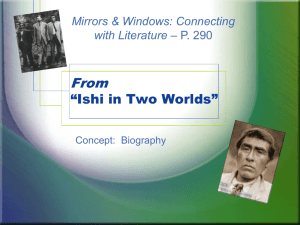
![[Date] Dear [Manager`s Name], I would like to attend the 26th](http://s3.studylib.net/store/data/006774637_1-eb1b8004553e5d07ebd94c17b8b25e4e-300x300.png)
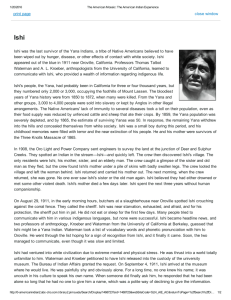
![Edward Sapir [1884-1939] - Frostburg State University](http://s2.studylib.net/store/data/005569801_1-deb1132f1ae8f0e8d561247b81673874-300x300.png)

